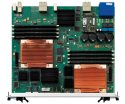CG Linux distro supports multicore MIPS64
Aug 27, 2008 — by Eric Brown — from the LinuxDevices Archive — 2 views MontaVista is touting its Carrier Grade Linux (CGL) distribution's support for Cavium's Octeon architecture. Using the architecture-specific registration available in version 4.0 of the CGL spec, it has registered its Carrier Grade Edition (CGE) 5.0 Linux product as “CGL 4.0-compliant for the Cavium… Octeon MIPS64 architecture.”
MontaVista is touting its Carrier Grade Linux (CGL) distribution's support for Cavium's Octeon architecture. Using the architecture-specific registration available in version 4.0 of the CGL spec, it has registered its Carrier Grade Edition (CGE) 5.0 Linux product as “CGL 4.0-compliant for the Cavium… Octeon MIPS64 architecture.”
(Click for larger view of ENP's Octeon- and MontaVista-based ATCA-9305 blade)
CGL 4.0's architecture-specific registration
 Dan Cauchy |
Platform specific compliance was added to the CGL spec with version 4.0. Dan Cauchy, the MontaVista marketing director who chairs the CGL workgroup, explains, “The Linux Foundation's CGL 4.0 registration is now architecture-specific. This change was made to make compliance differences visible for specific hardware architectures, which was not possible under previous CGL specifications.”
MontaVista registered CGE 5.0 for general CGL 4.0 compliance earlier this year. Other generic CGL 4.0 registrants include Performance Technologies, which registered its NexusWare distro, and Wind River, which registered its Platform for Network Equipment with the spec. As shown on the LF's CGL registration page, PT and MontaVista then went on to register architecture-specific compliance for i386, x86_64, and PPC (PowerPC) platforms, with MontaVista also adding registrations for PPC 85xx and PPC74xx.
MontaVista's Octeon support
MontaVista has long offered CGE for the Octeon architecture. It ported the latest release, CGE 5.0, to Octeon earlier this month. Cavium chips supported by CGE 5.0 reportedly include:
- CN58xx — Four- to 16-core SoCs claimed capable of “full-duplex” 10 Gigabit performance within tight power envelopes and size limitations
- CN56xx — Six to 12 MIPS64 cores up to 1GHz on a single chip, targets “intelligent” networking, control plane, and wireless applications, Cavium says
- CN52xx — Two- to four-core chips offering up to 4Gbps of network throughput for entry- to mid-level networking, wireless base stations, and storage services applications
- CN5000 — Low-power one- or two-core networking SoCs for “xPON/FTTx” (passive optical networking and fiber-to-the-home/office)
- CN3800 — Four- to 16-core parts targeting routers, intelligent switches, multi-service access equipment, storage servers, multi-protocol storage switches, border session gateways, and wireless infrastructure equipment
MontaVista's port of CGE 5.0 to Octeon was recently bundled with the Emerson Network Power ATCA-9305 (pictured at top), a network blade based on Octeon, and aimed at security and packet-processing applications for the wireless and transport markets. Other equipment providers, large and small, have also expressed interest in CGE for Octeon, MontaVista says.
Cauchy commented, “With up to 16 cores, Cavium Octeon processors [bring] an unprecedented level of performance for packet processing applications. CGE 5.0 fully supports the Cavium SDK 1.7, which allows our customers to access the full power of the packet processing capabilities of the Cavium processors.”
Cavium's (SDK) for Octeon also supports Wind River Linux.
MontaVista's standard support
MontaVista says CGE 5.0 met all 184 of the Priority 1 requirements mandated by the Carrier Grade Workgroup of the Linux Foundation (LF). The requirements cover availability, clustering, serviceability, performance, standards compliance, hardware support, and security. NEPs that purchase a CGL 4.0- registered distro are ensured of receiving all features deemed mandatory by NEPs and telecom carriers, according to the LF.
In July, MontaVista announced that CGE 5.0 also complied with the LF's Linux Standard Base (LSB) 3.0, and had been certified for IPv6 compliance by the IPv6 Forum. Although most of the major desktop distros have earned the LSB 3.0 badge, and all Linux distros offer some level of LBS compatibility, CGE still appears to be the only embedded Linux distribution to gain approval, according to LF's LSB registration page. LSB, now bumped up to version 3.1, comprises a set of standards meant to enable application portability across all LSB-compliant Linux distributions.
This article was originally published on LinuxDevices.com and has been donated to the open source community by QuinStreet Inc. Please visit LinuxToday.com for up-to-date news and articles about Linux and open source.